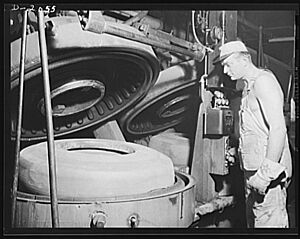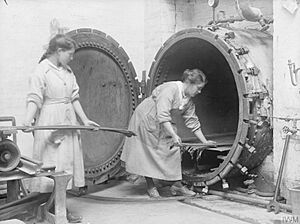Vulcanization facts for kids
Vulcanization is a special process that makes rubber much stronger and more useful. It was first used to treat natural rubber with sulfur. This is still the most common way to do it. But now, vulcanization also includes making other types of rubber, like synthetic ones, harder. For example, silicone rubber can be hardened at room temperature. Also, chloroprene rubber (which is known as neoprene) uses metal oxides to become strong.
Think of vulcanization as "curing" rubber. It creates tiny connections, called cross-links, between the long chains of rubber molecules. These connections make the rubber much stiffer and tougher. It also makes the rubber last longer. Once rubber is vulcanized, it usually cannot go back to its soft, original state. The name "vulcanization" comes from Vulcan, the Roman god of fire and volcanoes. This name was suggested by William Brockedon, a friend of Thomas Hancock, who got a patent for the process in Britain.
Contents
How Vulcanization Started
Long ago, people in ancient Mesoamerican cultures already used rubber. They made balls, sandal soles, and waterproof containers. They hardened their rubber using plant juices rich in sulfur. This was an early form of vulcanization.
In the 1830s, an inventor named Charles Goodyear worked on making rubber tires stronger. Back then, rubber tires would get soft and sticky when hot. They would pick up dirt and get punctured easily. Goodyear tried heating rubber with different chemicals. He found that heating the rubber itself made it harder. He didn't realize this at first.
One day in 1839, Goodyear was mixing rubber with sulfur. He accidentally dropped the mixture into a hot frying pan. To his surprise, the rubber didn't melt or disappear. Instead, it stayed firm. As he made it hotter, the rubber became even harder. Goodyear then figured out a way to consistently harden rubber. By 1844, he had a patent for his process. He began making vulcanized rubber on a large scale.
Around the same time, on November 21, 1843, a British inventor named Thomas Hancock also got a patent for vulcanizing rubber with sulfur. This was eight weeks before Charles Goodyear's patent in the U.S. It's debated whether Hancock learned about the process by looking at Goodyear's rubber samples.
What Vulcanized Materials Are Used For
Vulcanized rubber is used in many everyday items. Some examples include rubber hoses, shoe soles, and toys. It's also used for erasers, hockey pucks, and tires. You can find it in shock absorbers, conveyor belts, and bowling balls. Most rubber products are vulcanized. This greatly improves how long they last, how well they work, and how strong they are.
How Vulcanization Works
Unlike plastics that can be melted and reshaped, vulcanized rubber usually cannot be changed back. Once it's hardened, it stays that way.
There are five main ways to cure or vulcanize rubber:
- Using sulfur
- Using Peroxides
- Using metal oxides
- Using acetoxysilane
- Using urethane crosslinkers
Vulcanization with Sulfur
The most common way to vulcanize rubber uses sulfur. Sulfur alone works slowly. So, other chemicals are added to speed up the process. This mix of chemicals is called a "cure package."
The main types of rubber that use sulfur vulcanization are natural rubber and styrene-butadiene rubber (SBR). These are used for most car and truck tires. The cure package is carefully chosen for each type of rubber and what it will be used for.
During vulcanization, sulfur atoms create bridges between the rubber's long chains. These bridges can have one or more sulfur atoms. The number of sulfur atoms in these bridges affects the rubber's properties. Short bridges make the rubber more resistant to heat. Longer bridges make the rubber more flexible. Good flexibility is important for things like tire sidewalls that constantly bend. Without it, the rubber would crack quickly.
Vulcanization of Neoprene Rubber
Neoprene rubber, also called polychloroprene rubber, is vulcanized differently. It uses metal oxides like magnesium oxide and zinc oxide instead of sulfur. Special chemicals are also used to speed up this process. One important chemical for neoprene is ethylene thiourea (ETU). However, ETU is being replaced with safer options.
Vulcanization of Silicones
Silicone rubber can be vulcanized at room temperature. This is called Room-Temperature Vulcanizing (RTV) silicone. It's made from special liquid polymers mixed with strong mineral fillers.
There are two main types of RTV silicone:
- RTV-1 (One-part systems): These harden when exposed to moisture in the air. They come in airtight tubes as a liquid or paste. RTV-1 silicone sticks well, is stretchy, and lasts a long time. It can be very soft or quite firm. It's also great at resisting UV light and bad weather, so it doesn't age quickly.
- RTV-2 (Two-part systems): These come in two separate parts. When you mix them, they harden at room temperature into a solid, a gel, or a flexible foam. RTV-2 stays flexible in very cold or very hot temperatures. It can be used for electrical insulation because it doesn't conduct electricity well. RTV-2 is often used to make flexible molds and parts for industry or medical uses.
See also
 In Spanish: Vulcanización para niños
In Spanish: Vulcanización para niños
- ISO 2921
- Polymer stabilizers
- Sulfur concrete
- Vulcanized fibre
- Vulcanizing shop




